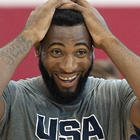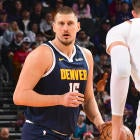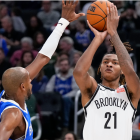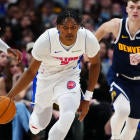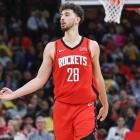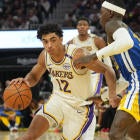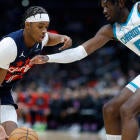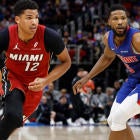Last week, we talked sleepers for the upcoming Fantasy basketball campaign, and settled on this as a definition for a sleeper: Someone who could surprise Fantasy owners but might not even get drafted in many leagues. Sleepers are the Hail Mary types, the players whose potential is tantalizing -- and tantalizingly unfulfilled to this point.
The definition for a breakout candidate is even simpler, but might be even more vague. Realistically, a breakout candidate could be anyone who has a chance to significantly outperform their draft position this season. It doesn't have to be someone young, though youth certainly helps. Still, it could be an old, familiar name who just happened to land in a better spot this season.
Breakout candidates tend to have a bit more of a track record, but also might be even more difficult to pin down. There are tons of different types of breakout candidates, so it makes sense to split them up heading into this season. I'll try to split the breakout candidates into three relatively vague categories, which will hopefully help you target what type of player you want to go after before defining who you target.
Category 1: The starter-turned star
This is the most obvious form of a breakout candidate, and the most valuable. Think Jimmy Butler last season or Gordon Hayward the year before.
Andre Drummond, C, Pistons
Drummond's third season was a disappointing one, which says a lot about how high expectations were for him. First, the good stuff: Drummond led the league in offensive rebounding rate for the second year in a row, and became just the third player since 1979-80 to average at least 15 points and 15 rebounds per-36 minutes in over 2,000 minutes. The bad news is, Drummond shot below 60 percent from the field for the first time in his career, as an increased offensive workload left him somewhat lost at times. Toss in his untenable free-throw shooting, and Drummond still has some hurdles to clear before being considered a truly elite Fantasy option.
I think he gets there this season. The Pistons didn't give Drummond much room to operate down low last season, as he played in lineups with too much Greg Monroe and Josh Smith. This season, the Pistons should be able to run stretch-fours Ersan Ilyasova and Marcus Morris out there all game long, meaning defenses will have to choose between free rolls to the rim for Drummond or wide-open 3-pointers. When he played with Anthony Tolliver, the team's only true stretch-four last season, Drummond averaged 18.9 points and 16.5 rebounds per-36 minutes and shot 55.5 percent from the field. He might be a first-round pick by this time next year.
Jonas Valanciunas, C, Raptors
When thinking about Valanciunas' career so far, it is best to consider a pot of water set to boil. If you watch it too closely, you might be disappointed at the lack of action. His per-game production has trended up slightly, but we still haven't seen him boil over with a truly massive season. However, Valanciunas has increased his per-minute production steadily, and quietly averaged 16.5 points, 11.9 rebounds and 1.6 blocks per-36 minutes last season, pretty terrific numbers for a 22-year-old. Valanciunas doesn't have Drummond's upside, but there's no reason he can't be a solid starting Fantasy option every week if Dwane Casey will just loosen the reigns.
Victor Oladipo, G, Magic
If you were paying attention, you might have realized that Oladipo's breakout already happened last season. He took his game to another level in the second half last season, averaging 20.3 points, 4.3 rebounds and 4.5 assists per game, borderline elite numbers for Fantasy. However, he still has room to improve his efficiency, and that will be the key to becoming a star on a Magic team that has a lot of mouths to feed. If Oladipo can get to the free-throw line more this season, or improve his 3-point shooting to closer to league-average, 20-5-5 isn't out of the question; Blake Griffin, Russell Westbrook, LeBron James and James Harden were the only players who managed that feat last season.
Robert Covington, F, 76ers
The 76ers factor heavily into any preseason list of breakout or sleeper candidates, just because they have so many players who could potentially see a much larger-than-expected role. Covington's role seems pretty settled, but there is still plenty of room for the 24-year-old to grow after a solid season with the 76ers. He already broke out last season by averaging 13.5 points and making 167 3-pointers, but he should take things to another level this season after he averaged 18.3 points, 4.4 rebounds and 2.1 assists in nearly 30 minutes per game in April. Covington is one of the only sure things on the wings for the Sixers, and brings desperately needed shooting, so don't be totally surprised if he leads them in scoring this season..
Category 2: The reserve-turned-starter
Usually younger, with a strong draft pedigree and brief flashes of elite production. Think Gorgui Dieng last season.
Terrence Jones, F, Rockets
Last season was supposed to be Jones' breakout season, and he got off to a fine start by averaging 14.0 points, 7.5 rebounds, 0.8 3-pointers and 2.8 combined blocks and steals in the first four games of the season. Unfortunately, a nerve issue cost him nearly three months of action, and he struggled with consistency upon returning in late January. Another stretch after the All-Star break saw him averaging 14.8 points, 9.5 rebounds and 1.9 blocks per game in a 14-game stretch, but another injury stopped that stretch cold. These glimpses are enticing, and if he can stay healthy and replicate them for a full season, he should be a tremendous value on Draft Day..
Dennis Schroder, G, Hawks
This one might be a year too earlier, but I'm willing to bet on Schroder's talent here. The marks against Schroder are pretty glaring -- he's a limited shooter and won't have a starting role this season anyways -- but there's a lot to like about what he did last season and can still accomplish moving forward. The 21-year-old started 10 games in relief of Jeff Teague last season and averaged 14.1 points and 7.7 assists in 29.2 minutes per game. Teague's continued presence presents a significant roadblock, but Schroder is well worth drafting this season given his potential.
Mason Plumlee, C, Trail Blazers
We've already seen what Plumlee can do when he gets the minutes, so this is more about his role. After languishing behind a resurgent Brook Lopez for much of last season, Plumlee should be cleared for a much larger and more consistent role in Portland this season. In 42 games where he has played at least 25 minutes in his career, Plumlee is averaging 14.4 points, 8.8 rebounds and 2.5 combined blocks and steals in 20.7 minutes per game, solid numbers for any center, let alone one you could get in the latter half of your draft.
Jusuf Nurkic, C, Nuggets
Nurkic seems a bit out of place among the rest of the names here, but I don't think he necessarily qualifies as a sleeper either; there was a lot of buzz around him for a while last season. His season numbers aren't terribly impressive, but take a look at what he managed in 14 games where he played at least 25 minutes as a 20-year-old:
11.0 points, 9.6 rebounds, 2.8 combined blocks and steals in 28.1 minutes
Nurkic is extremely young and raw, and efficiency was a real issue for him. However, he has huge upside in Rotisserie leagues if he can improve his touch and hold on to the ball a little better. As a late-round flier, he has a great chance to provide a return on investment.
Category 3: The bounce-back candidate
These players have been stars in the past, but are coming off a down year for whatever reason. Think Danilo Gallinari last season.
Nicolas Batum, F, Hornets
If you've got a short memory, you might need to be reminded that Batum was considered a top-20 Fantasy player just a year ago. He struggled with his shot and ended up posting the lowest scoring average of his career. We can hope a change of scenery will do him good because Batum was still pretty tremendous outside of scoring and shooting, averaging 6.3 rebounds, 5.2 assists and 1.2 steals per game for the Blazers last season. If he can become a 15-PPG threat again, Batum could be a huge bargain as a fifth-round pick.
David Lee, F, Celtics
From 2008-09 through 2013-14, David Lee was one of the most consistent players in the NBA, averaging a double-double in three of six seasons and averaging 18.2 points, 10.7 rebounds and 2.9 assists per game over a stretch of 440 games. Then he got hurt in last year's preseason and ended up playing just 904 minutes for the Warriors and posting his least productive season since he was a rookie. The Warriors won a championship and then promptly traded Lee to the Celtics, a much better situation for his Fantasy appeal, though still not a perfect one. If he can earn a consistent 25-MPG role with Boston, don't be surprised if Lee gets back to Fantasy relevance, but he'll have to fight for playing time with Jared Sullinger, Kelly Olynyk and Amir Johnson first..
Rajon Rondo, G, Kings
Here's how far Rondo's stock has fallen: in a recent mock draft I did, he went 124th overall, behind the likes of Trey Burke, Jae Crowder and Alex Len. Rondo was once the league's preeminent double-double specialist, but just hasn't been the same since returning from a torn ACL in 2013. He still finished last season with 7.9 assists and 5.6 rebounds per game, but has become a non-factor pretty much everywhere else on the stat sheet. He signed a one-year make-good deal with the Kings, and has some upside in an offense that should play fast and give him plenty of opportunities for assists. Maybe the league has left Rondo and his poor shooting behind, or maybe the injury has really sapped him of his ability to penetrate set defenses. All I know is, if Rondo is going five rounds after Ricky Rubio, who has missed 110 of 312 games in his NBA career. There's value to be found here.
Roy Hibbert, C, Lakers
It's hard not to be frustrated with how Hibbert's career has gone. He peaked in 2011-12 as an All-Star who averaged 12.8 points, 8.8 rebounds and 2.0 blocks per game, but has seen his production trail off considerably since. To make matters worse, he averaged just 1.6 blocks per game in 2014-15, his lowest total since 2009-10, and a big reason his Fantasy value fell even further. The good news is, like everyone else in this category, Hibbert has a new home and a new opportunity to fix his reputation. The Lakers shouldn't need much from him offensively, but with a likely starting perimeter trio made up of rookie D'Angelo Russell, Jordan Clarkson and Kobe Bryant, Hibbert is going to get plenty of opportunities to protect the rim. If Hibbert can get above 2.0 blocks per game, everything else is gravy. I love the idea of drafting my first center in the first two rounds and then waiting to target Hibbert in the Round 9-10 range as a No. 2 center.







